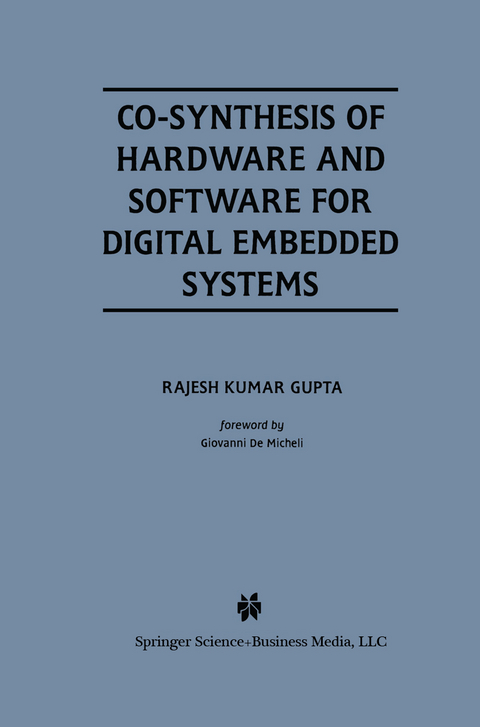
Co-Synthesis of Hardware and Software for Digital Embedded Systems
Springer-Verlag New York Inc.
978-1-4613-5965-4 (ISBN)
Recent advances in chip-level synthesis have made it possible to synthesize application-specific circuits under strict timing constraints. This work advances the state of the art by formulating the problem of system synthesis using both application-specific as well as reprogrammable components, such as off-the-shelf processors. Timing constraints are used to determine what part of the system functionality must be delegated to dedicated application-specific hardware while the rest is delegated to software that runs on the processor. This co-synthesis of hardware and software from behavioral specifications makes it possible to realize real-time embedded systems using off-the-shelf parts and a relatively small amount of application-specific circuitry that can be mapped to semi-custom VLSI such as gate arrays. The ability to perform detailed analysis of timing performance provides the opportunity of improving the system definition by creating better phototypes.
Co-Synthesis of Hardware and Software for Digital Embedded Systems is of interest to CAD researchers and developers who want to branch off into the expanding field of hardware/software co-design, as well as to digital system designers who are interested in the present power and limitations of CAD techniques and their likely evolution.
1 Introduction.- 1.1 Design of Embedded Systems.- 1.2 Synthesis Solutions.- 1.3 Co-design and Co-synthesis.- 1.4 Motivations for Hardware-Software Co-synthesis.- 1.5 Applications.- 1.6 The Opportunity of Co-synthesis.- 1.7 Scope and Contributions.- 1.8 Outline of the Book.- 2 Related Work.- 2.1 CAD Systems for Hardware-Software Co-design.- 2.2 CAD for Hardware-Software Co-synthesis.- 3 System Modeling.- 3.1 System Specification using Procedural HDL.- 3.2 System Model and its Representation.- 3.3 The Flow Graph Model.- 3.4 Interaction Between System and its Environment.- 3.5 ND,Execution Rate and Communication.- 3.6 Constraints.- 3.7 Summary.- 4 Constraint Analysis.- 4.1 Scheduling of Operations.- 4.2 Deterministic Analysis of Min/max Delay Constraints.- 4.3 Deterministic Analysis of Execution Rate Constraints.- 4.4 Constraints Across Graph Models.- 4.5 ND Cycles in A Constraint Graph.- 4.6 Probabilistic Analysis of Min/max and Rate Constraints.- 4.7 Flow Graph as a Stochastic Process.- 4.8 Summary.- 5 Software and Runtime Environment.- 5.1 Processor Cost Model.- 5.2 A Model for Software and Runtime System.- 5.3 Estimation of Software Performance.- 5.4 Estimation of Software Size.- 5.5 Software Synthesis.- 5.6 Step I: Generation of Program Threads.- 5.7 Step II: Generation of Program Routines.- 5.8 Step III: Code Synthesis.- 5.9 Issues in Code Synthesis from Program Routines.- 5.10 Summary.- 6 System Partitioning.- 6.1 Partition Cost Model.- 6.2 Local versus Global Properties.- 6.3 Partitioning Feasibility.- 6.4 Partitioning Based on Separation of Control and Execute Procedures.- 6.5 Partitioning Based on Division of ND Operations.- 6.6 Partition Related Transformations.- 6.7 Summary.- 7 System Implementation.- 7.1 Vulcan System Implementation.- 7.2 Implementation of Target Architecture in Vulcan.- 7.3 Co-simulation Environment.- 7.4 Summary.- 8 Examples and Results.- 8.1 Graphics Controller.- 8.2 Network Controller.- 9 Summary, Conclusions, and Future Work.- 9.1 Future Work.- References.
| Reihe/Serie | The Springer International Series in Engineering and Computer Science ; 329 |
|---|---|
| Zusatzinfo | XVII, 266 p. |
| Verlagsort | New York, NY |
| Sprache | englisch |
| Maße | 155 x 235 mm |
| Themenwelt | Informatik ► Weitere Themen ► CAD-Programme |
| Technik ► Elektrotechnik / Energietechnik | |
| ISBN-10 | 1-4613-5965-1 / 1461359651 |
| ISBN-13 | 978-1-4613-5965-4 / 9781461359654 |
| Zustand | Neuware |
| Haben Sie eine Frage zum Produkt? |
aus dem Bereich


